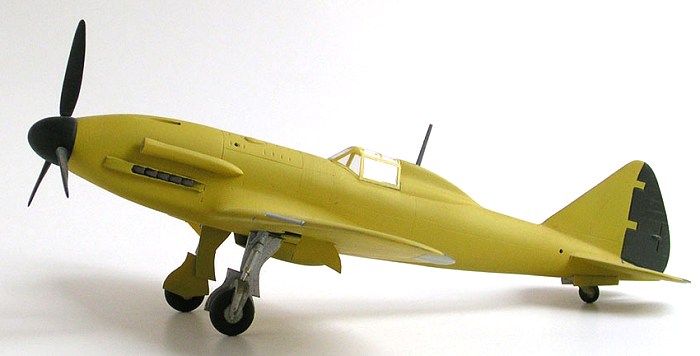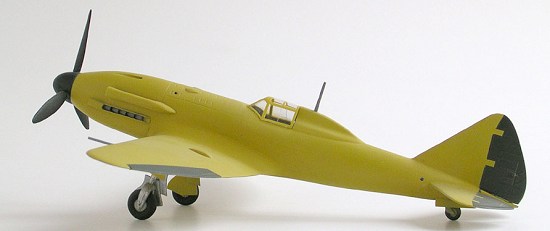
Falcon 1/48 Re.2006 conversion
|
KIT # |
? |
|
PRICE: |
$ |
|
DECALS: |
? |
|
REVIEWER: |
Chris Busbridge |
|
NOTES: |
Scrath-built conversion |

|
HISTORY |
 Together with both the Fiat G.56 and the Macchi C.206, the RE.2006 was a
highly secret project. They were all modified versions of the Type 5
fighters, designed to be fitted with the DB.603 engine. Although the
Macchi never got past the design stage (confirmed in the RE.2006 book),
both the G.56 and RE.2006 did get built, although the RE.2006 never flew.
With cramped working conditions and a furtive construction to keep the
Germans unaware of its whereabouts, it was a miracle the plane got built
at all. With the Allied advancing well into Italy at the time, it was
decided to hand it over to them, but it unfortunately it was broken up
without ever getting a chance to fly.
Together with both the Fiat G.56 and the Macchi C.206, the RE.2006 was a
highly secret project. They were all modified versions of the Type 5
fighters, designed to be fitted with the DB.603 engine. Although the
Macchi never got past the design stage (confirmed in the RE.2006 book),
both the G.56 and RE.2006 did get built, although the RE.2006 never flew.
With cramped working conditions and a furtive construction to keep the
Germans unaware of its whereabouts, it was a miracle the plane got built
at all. With the Allied advancing well into Italy at the time, it was
decided to hand it over to them, but it unfortunately it was broken up
without ever getting a chance to fly.|
CONSTRUCTION |
 After careful study of the Ali d'Italia profile, as well as the
information given in the IBN dossier, I felt confident that the Falcon
model could be converted to look something like an RE.2006. First off,
the decals and paint were removed from the kit, as well as the
undercarriage, carb intake, prop etc. Then it was time to bring out the
razor saw and start dismembering the fuselage! Using panel lines as a
guide, I carefully separated the upper and lower cowlings, the tail
section and the fuselage gun compartment from the main fuselage. The
remaining rear and cockpit fuselage section was split from the wing
assembly by repeatedly scribing along the top wing fillet panel line
until it had broken through. A saw cut was made across the base
After careful study of the Ali d'Italia profile, as well as the
information given in the IBN dossier, I felt confident that the Falcon
model could be converted to look something like an RE.2006. First off,
the decals and paint were removed from the kit, as well as the
undercarriage, carb intake, prop etc. Then it was time to bring out the
razor saw and start dismembering the fuselage! Using panel lines as a
guide, I carefully separated the upper and lower cowlings, the tail
section and the fuselage gun compartment from the main fuselage. The
remaining rear and cockpit fuselage section was split from the wing
assembly by repeatedly scribing along the top wing fillet panel line
until it had broken through. A saw cut was made across the base
of the fuselage to complete the process.

I clean forgot to take any in-progress shots, but hopefully the diagram
should describe how the aircraft was split apart.
I used several plies of thick plasticard to extend the length of the
fuselage. With the cowlings pretty much in the same position as the
RE.2005, a 3mm mm insert was added between the upper and lower cowlings
to deepen it's cross section, a 2.5mm plug was added between the front of
the cowling and the VDM spinner (an alternative part in the Falcon kit).
The gun compartment was applied to the back of the deepened cowling and
 had a 3mm insert put underneath it. Another 12.5mm plug was added between
the gun compartment and the cockpit/rear fuselage section, which in turn
had another 5mm plug added between it and the largely unchanged tail
section, thus increasing the length of the fuselage by a full 19.5mm! The
last gap left to fill was between the cockpit/rear fuselage section and
the wing. This was done by using more strips of plasticard, the cockpit
side-walls as acting as support. Milliput was used to increase the cross
section of the rear fuselage. Needless to say, several filling and
sanding sessions were necessary before a smooth looking fuselage was
achieved.
had a 3mm insert put underneath it. Another 12.5mm plug was added between
the gun compartment and the cockpit/rear fuselage section, which in turn
had another 5mm plug added between it and the largely unchanged tail
section, thus increasing the length of the fuselage by a full 19.5mm! The
last gap left to fill was between the cockpit/rear fuselage section and
the wing. This was done by using more strips of plasticard, the cockpit
side-walls as acting as support. Milliput was used to increase the cross
section of the rear fuselage. Needless to say, several filling and
sanding sessions were necessary before a smooth looking fuselage was
achieved.
All the other bits and bobs were then re-assembled, not forgetting to
include the splitter plate in the combined radiator and oil cooler
fairing.
|
COLORS AND MARKINGS |
 As no photographs exist of the RE.2006, a reasonable assumption would be
to colour it the same way as the RE.2005 prototype, which was grey
overall, with ready camouflaged control surfaces. However, eye witness
accounts proved it had a yellow-ish colour, but still with the ready
camouflaged control surfaces. The yellow is likely to be a zinc chromate
yellow, so I used Humbrol 81.
As no photographs exist of the RE.2006, a reasonable assumption would be
to colour it the same way as the RE.2005 prototype, which was grey
overall, with ready camouflaged control surfaces. However, eye witness
accounts proved it had a yellow-ish colour, but still with the ready
camouflaged control surfaces. The yellow is likely to be a zinc chromate
yellow, so I used Humbrol 81.
It is possible to use alternative "what-if" schemes. Had history taken a
different course, it may well have sported German markings, just like the
G.56. Alternatively, it could have seen service as part of the Co-Belligerante.
For historical accuracy though, your only choice is this yellow scheme.
|
CONCLUSIONS |
April 2004 Copyright ModelingMadness.com. All rights reserved.
No reproduction in any form without express permission from the editor.
Any one who fancies a go at this type of conversion will probably find it
fun, as absolute accuracy is not critical. I certainly enjoyed it and the
added bonus was the simple colour scheme showing the clean lines of this
lost Reggiane masterpiece to good effect.
If you would like your product reviewed fairly and fairly quickly, please contact the editor or see other details in the Note to Contributors.